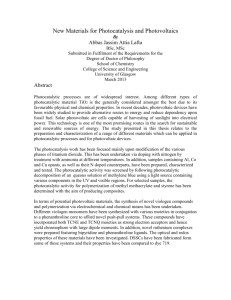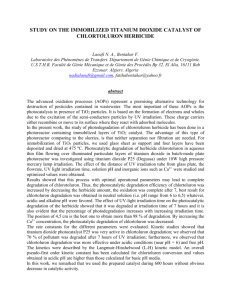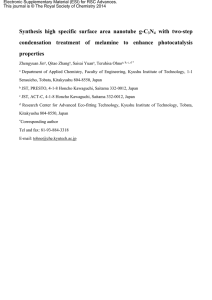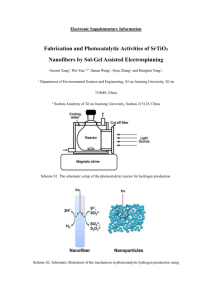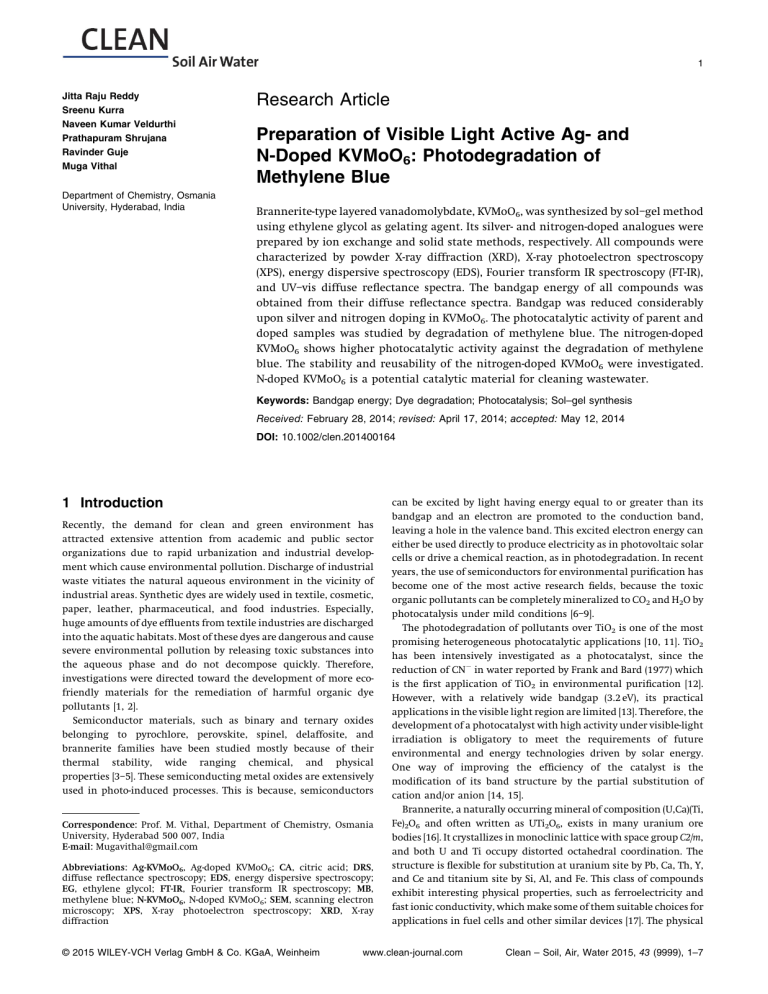
1 Jitta Raju Reddy Sreenu Kurra Naveen Kumar Veldurthi Prathapuram Shrujana Ravinder Guje Muga Vithal Department of Chemistry, Osmania University, Hyderabad, India Research Article Preparation of Visible Light Active Ag- and N-Doped KVMoO6: Photodegradation of Methylene Blue Brannerite-type layered vanadomolybdate, KVMoO6, was synthesized by sol–gel method using ethylene glycol as gelating agent. Its silver- and nitrogen-doped analogues were prepared by ion exchange and solid state methods, respectively. All compounds were characterized by powder X-ray diffraction (XRD), X-ray photoelectron spectroscopy (XPS), energy dispersive spectroscopy (EDS), Fourier transform IR spectroscopy (FT-IR), and UV–vis diffuse reflectance spectra. The bandgap energy of all compounds was obtained from their diffuse reflectance spectra. Bandgap was reduced considerably upon silver and nitrogen doping in KVMoO6. The photocatalytic activity of parent and doped samples was studied by degradation of methylene blue. The nitrogen-doped KVMoO6 shows higher photocatalytic activity against the degradation of methylene blue. The stability and reusability of the nitrogen-doped KVMoO6 were investigated. N-doped KVMoO6 is a potential catalytic material for cleaning wastewater. Keywords: Bandgap energy; Dye degradation; Photocatalysis; Sol–gel synthesis Received: February 28, 2014; revised: April 17, 2014; accepted: May 12, 2014 DOI: 10.1002/clen.201400164 1 Introduction Recently, the demand for clean and green environment has attracted extensive attention from academic and public sector organizations due to rapid urbanization and industrial development which cause environmental pollution. Discharge of industrial waste vitiates the natural aqueous environment in the vicinity of industrial areas. Synthetic dyes are widely used in textile, cosmetic, paper, leather, pharmaceutical, and food industries. Especially, huge amounts of dye effluents from textile industries are discharged into the aquatic habitats. Most of these dyes are dangerous and cause severe environmental pollution by releasing toxic substances into the aqueous phase and do not decompose quickly. Therefore, investigations were directed toward the development of more ecofriendly materials for the remediation of harmful organic dye pollutants [1, 2]. Semiconductor materials, such as binary and ternary oxides belonging to pyrochlore, perovskite, spinel, delaffosite, and brannerite families have been studied mostly because of their thermal stability, wide ranging chemical, and physical properties [3–5]. These semiconducting metal oxides are extensively used in photo-induced processes. This is because, semiconductors Correspondence: Prof. M. Vithal, Department of Chemistry, Osmania University, Hyderabad 500 007, India E-mail: Mugavithal@gmail.com Abbreviations: Ag-KVMoO6, Ag-doped KVMoO6; CA, citric acid; DRS, diffuse reflectance spectroscopy; EDS, energy dispersive spectroscopy; EG, ethylene glycol; FT-IR, Fourier transform IR spectroscopy; MB, methylene blue; N-KVMoO6, N-doped KVMoO6; SEM, scanning electron microscopy; XPS, X-ray photoelectron spectroscopy; XRD, X-ray diffraction © 2015 WILEY-VCH Verlag GmbH & Co. KGaA, Weinheim can be excited by light having energy equal to or greater than its bandgap and an electron are promoted to the conduction band, leaving a hole in the valence band. This excited electron energy can either be used directly to produce electricity as in photovoltaic solar cells or drive a chemical reaction, as in photodegradation. In recent years, the use of semiconductors for environmental purification has become one of the most active research fields, because the toxic organic pollutants can be completely mineralized to CO2 and H2O by photocatalysis under mild conditions [6–9]. The photodegradation of pollutants over TiO2 is one of the most promising heterogeneous photocatalytic applications [10, 11]. TiO2 has been intensively investigated as a photocatalyst, since the reduction of CN in water reported by Frank and Bard (1977) which is the first application of TiO2 in environmental purification [12]. However, with a relatively wide bandgap (3.2 eV), its practical applications in the visible light region are limited [13]. Therefore, the development of a photocatalyst with high activity under visible-light irradiation is obligatory to meet the requirements of future environmental and energy technologies driven by solar energy. One way of improving the efficiency of the catalyst is the modification of its band structure by the partial substitution of cation and/or anion [14, 15]. Brannerite, a naturally occurring mineral of composition (U,Ca)(Ti, Fe)2O6 and often written as UTi2O6, exists in many uranium ore bodies [16]. It crystallizes in monoclinic lattice with space group C2/m, and both U and Ti occupy distorted octahedral coordination. The structure is flexible for substitution at uranium site by Pb, Ca, Th, Y, and Ce and titanium site by Si, Al, and Fe. This class of compounds exhibit interesting physical properties, such as ferroelectricity and fast ionic conductivity, which make some of them suitable choices for applications in fuel cells and other similar devices [17]. The physical www.clean-journal.com Clean – Soil, Air, Water 2015, 43 (9999), 1–7 2 J. R. Reddy et al. properties can be changed significantly by small variations in the compositions leading to materials with the required set of characteristics for developing components of new devices. In this connection, the layered type brannerites (containing vanadium, molybdenum, and tungsten) have generated a new interest as electrode materials [18, 19]. Previous reports have shown that transition metal vanadates of general composition AVMO6 (A ¼ Li, Na, K and M ¼ Mo, W) are used as promising anode materials and catalysts due to their high-specific capacity and layered crystal structure. One of the earliest works on these materials, by Natividad et al., involved the study of partial oxidation of benzyl alcohol into benzaldehyde under UV light [20]. The research pertaining to the photocatalysis of these layered brannerites is limited in spite of their flexible properties. Thus, the object of our present work is to study the photocatalytic properties of brannerite type oxides containing vanadium, molybdenum, and alkali metals. These brannerite type oxides are flexible to undergo ion exchange with guest ions and make them promising materials for photocatalytic applications. To date, a large number of scientific investigations about the photocatalytic degradation of aqueous organic pollutants, such as aliphatic alcohols, alkenes, phenols, dyes, and aromatic compounds have been reported [21–24]. In the present investigation, we focused our attention on the degradation of methylene blue (MB), which is usually used as a probe contaminant to evaluate the activity of the photocatalyst. It is widely used as a paper dye, microscopy stain, chemical intermediate, medicinal agent, and cosmetic dye, which may result in its release to the environment through various waste streams. Toxic MB is chemically inert and stable in the environment, and it is not easy to remove from wastewater because of the high stability and solubility in water. It is harmful to the skin, eyes, respiratory tract, and causes anemia. In the continuation of our studies on photocatalytic degradation of organic pollutants, attempts are made to vary the band structure of KVMoO6, a brannerite-type layered oxide, by partial substitution of K and O with Ag and N, respectively. Silver is an extremely attractive dopant due to its remarkable catalytic activity. In the photocatalytic process, Agþ acts as a sink for photo-induced charge carriers, could promote interfacial charge transfer processes and inhibit the recombination of photogenerated electron–hole pairs due to its strong electron trap ability. In addition, nitrogen doping has been proven to be very promising because the implantation of nitrogen creates oxygen vacancies that are traps for excited electrons leading to a reduction in recombination of photo-induced electron–hole pairs. Therefore, silver and nitrogen were chosen as the dopants in this study to enhance the photocatalytic activity of KVMoO6 [25, 26]. This paper deals with preparation, characterization and photocatalytic studies of Ag- and N-doped KVMoO6. 2 Materials and methods 2.1 Synthesis of N- and Ag-doped KVMoO6 The preparation of potassium vanadomolybdate (KVMoO6) was carried out by the modified sol–gel method which was earlier reported by Mucha et al. [27]. NH4VO3 (S-D Fine), (NH4)6Mo7O24) 6H2O (Sigma– Aldrich), KNO3 (Merck), citric acid (S-D Fine), and ethylene glycol are used as the starting materials as received. In a typical synthetic process, the stoichiometric amounts of NH4VO3 (1.24 g, 10.63 mmol), (NH4)6Mo7O24 6H2O (1.87 g, 1.51 mmol), and KNO3 (1.07 g, 10.63 mmol) were dissolved in water. Citric acid (CA) (9.56 g, 45.54 mmol) was added © 2015 WILEY-VCH Verlag GmbH & Co. KGaA, Weinheim to this solution such that the mole ratio of metal ions to CA is 1:2. The mixture was stirred for several hours at room temperature followed by slow evaporation till a viscous liquid was obtained. At this stage, ethylene glycol (EG) (2.7 mL, 50.09 mmol) was added in the molar ratio of metal ions to EG as 1:2.4. This mixture was heated on a hot plate at 160°C for 2–3 h. The temperature was increased to 200°C at the onset of solidification to get dried powder. The resultant powder was heated in a muffle furnace in air at 350°C/24 h, 400°C/24 h, and 450°C/24 h with intermittent grindings. The N-doped KVMoO6 (N-KVMoO6) was prepared using urea as reported earlier [28]. A thoroughly ground mixture of KVMoO6 and urea (CO(NH2)2) in the weight ratio of 1:2 was heated at 400°C for 2 h in a muffle furnace in air. The resultant material was washed with distilled water to remove unreacted urea (or byproducts) and dried in air. The silver doping of KVMoO6 (Ag-KVMoO6) was performed by ion-exchange process. Firstly, 0.6 g (3.5 mmol) of AgNO3 was dissolved in 50 mL of distilled water. To this solution 1 g (3.5 mmol) of KVMoO6 was added under constant stirring. The color of the powder changed slowly, and the stirring was continued for 12 h under ambient condition. The solid was separated and washed with distilled water several times and dried in air. 2.2 Characterization The room temperature X-ray diffractograms of all samples were recorded using Rigaku MiniFlex 600 X-ray diffractometer (Cu Ka, l ¼ 1.5406 Å , 2u ¼ 10°–80°, step size (2u) ¼ 0.02°, and scan step time ¼ 0.15 s) for phase confirmation. The chemical analysis of the samples was carried out by X-ray photoelectron spectroscopy (XPS) (model ESCALAB220I-XL) equipped with an Axis Ultra, Kratos (1486.7 eV) monochromatic source for excitation. XPS spectra over a binding energy range of 0–1200 eV were obtained using analyzer pass energy of 117.4 eV. Scanning electron microscopy with energy dispersive spectra (SEM-EDS) were recorded on the HITACHI SU-1500 variable pressure scanning electron microscope. Fourier transform IR spectroscopy (FT-IR) was recorded using Shimadzu spectrometer in the form of KBr pellets. JASCO V-650 UV–Vis spectrophotometer was used for UV–Vis diffuse reflectance spectroscopy (DRS) in the range of 200–800 nm. BaSO4 was used as the reflectance standard. 2.3 Photocatalytic experiments The photocatalytic activity of all samples was evaluated by photodegradation of MB using HEBER Visible Annular Type Photoreactor, model HVAR1234 (Haber Scientific, India), under visible light irradiation using 500 W tungsten lamp as a light source. The system was cooled by circulating water and maintained at room temperature. In a typical process, 60 mL of aqueous MB solution (10 mg L1) was stirred with 0.06 g of catalyst in a cylindrical-shaped glass reactor at room temperature in air. The suspension was stirred in the dark for 60 min to establish adsorption–desorption equilibrium. Then the solution was exposed to light with continuous stirring. At regular 30 min intervals, about 3 mL of solution was collected and centrifuged to remove the catalyst particles. The change in the concentration of MB was obtained by recording the absorbance at 664 nm using a UV–vis spectrophotometer. 3 Results and discussion The structure and phase purity of all the prepared compositions were analyzed by recording the powder X-ray diffraction (XRD). www.clean-journal.com Clean – Soil, Air, Water 2015, 43 (9999), 1–7 General Figure 1. Powder X-ray diffraction patterns of KVMoO6, Ag-KVMoO6 and N-KVMoO6. Figure 1 shows the XRD pattern of KVMoO6 along with the silver- and nitrogen-doped KVMoO6. The XRD patterns of all the samples are consistent with the published Powder Diffraction data of KVMoO6 which crystallizes in orthorhombic lattice (JCPDF: 89-4563). All powder patterns are free from impurities and confirm the phase formation. The powder patterns of Ag- and N-doped KVMoO6 are similar with parent KVMoO6 suggesting that the doping did not alter the original crystal structure. However, a careful observation of the diffraction pattern of Ag- and N-doped KVMoO6 shows a shift in the position of d-lines with respect to the parent KVMoO6 (Fig. 1, inset). The systematic peak shifting indicates that silver and nitrogen are successfully doped into the KVMoO6 lattice. The substitution of silver and nitrogen into KVMoO6 is supported by XPS and SEM-EDS measurements. The X-ray photoelectron spectrum of KVMoO6 is shown in Fig. 2. The survey spectrum of KVMoO6 reveals the presence of peaks belonging to K2p (293.0 0.5 eV), V2p (517 0.5 eV), Mo3d (233 0.5 eV), and O1s (530 0.5 eV). The observed peak positions of constituent elements Figure 2. XPS survey spectrum of KVMoO6. © 2015 WILEY-VCH Verlag GmbH & Co. KGaA, Weinheim 3 of KVMoO6 are in agreement with previous reports [20, 29]. The X-ray photoelectron survey spectrum of silver- and nitrogen-doped KVMoO6 also shows these peaks along with additional peaks of silver and nitrogen, respectively. The presence of silver/nitrogen in doped samples is examined by analyzing their high resolution X-ray photoelectron spectra. Figure 3a and b displays the Ag3d and N1s spectra of Ag-KVMoO6 and N-KVMoO6, respectively. Generally, the existence of Agþ ion can be identified by the observation of Ag3d peak in the binding energy 367–372 eV range [20]. The spectrum (Fig. 3a) shows two peaks centered at 367.95 and 373.85 eV corresponding to 3d5/2 and 3d3/2 states, respectively [30]. The spin– orbit splitting is 5.90 eV which is close to the reported value. The Xray photoelectron spectrum of N-KVMoO6 for the N1s peak exhibits a symmetrical peak centered at 396.95 eV (Fig. 3b), which is attributed to the substitutional nitrogen in place of oxygen in the lattice [31]. Thus, the XPS results authenticate the presence of silver and nitrogen in Ag-KVMoO6 and N-KVMoO6, respectively. The presence of doped elements in the KVMoO6 lattice was further substantiated by their SEM-EDS profiles. The SEM figures of all the samples are shown in Fig. 4a, and revealed that the morphology of the crystallites were not altered even after (Ag and N) doping. Figure 4b shows the energy dispersive spectra (EDS) of parent and doped samples. The appearance of Ag and N peaks in Ag-KVMoO6 and N-KVMoO6, respectively, clearly indicates their substitution in the lattice. From these EDS profiles, the content (weight ratio, wt%) of the silver and nitrogen in Ag-KVMoO6 and N-KVMoO6 was found to be 5.93 and 2.93 wt%, respectively. Therefore, these results further support the presence of silver and nitrogen in the KVMoO6 lattice. Figure 5 shows the FT-IR Spectra of KVMoO6, Ag-KVMoO6, and N-KVMoO6. The vibrational spectra of all investigated vanadates are similar to each other and comparable with reported systems [29, 32]. The structure of KVMoO6 is characterized by distorted VO6 and MoO6 octahedra sharing edges. Alkali metal ions are located in interlayers and form M0 O6 (M0 ¼ Li, Na, and K) coordination polyhedra [33]. The bands seen in the high frequency region (800–1000 cm1) were assigned to (V/Mo)O6 stretching vibrations. The strong bands observed around 960 cm1 were attributed to vibrations of the terminal (V/Mo)¼O groups and very weak bands found near 939 cm1 were assigned to some overtone or combination bands. The strong and weak bands found in the regions 800–930 cm1 were recognized as asymmetric stretching vibrations of (V/Mo)–O–(V/Mo) bridges. Similarly, strong and very broad bands seen in the regions 660–730 and 450–650 cm1, respectively, are described as symmetric stretching of (V/Mo)¼O. The bands identified below 450 cm1 with medium and weak intensity were represented to both the bending modes of (V/Mo)¼O and translational modes of M0 O6 polyhedra. The optical properties of KVMoO6, Ag-KVMoO6, and N-KVMoO6 are examined from their UV-Vis diffuse reflectance spectroscopy (DRS) (Fig. 6). All the DRS profiles have absorption edges in the visible region, which is in agreement with their colors (Fig. 6, inset). The absorption edges of KVMoO6, Ag-KVMoO6, and N-KVMoO6 are located at 454, 480, and 516 nm, respectively. The significant feature of doped samples is the red shift of the absorption edge into mid visible region. Bandgap energy of all the compounds is calculated from the Kubelka Munk (KM) plots, [F(Ra) hn]1/2 versus hn (eV) where F(Ra) is absorption coefficient and hn is a photon energy (Fig. 6, inset). From these plots, the bandgap energy of KVMoO6, Ag-KVMoO6, and NKVMoO6 are found to be 2.73, 2.58, and 2.40 eV, respectively. The lowering of the bandgap energy of silver- and nitrogen-doped photocatalysts compared to parent KVMoO6 is due to the www.clean-journal.com Clean – Soil, Air, Water 2015, 43 (9999), 1–7 4 J. R. Reddy et al. Figure 3. XPS spectrum of (a) core level Ag3d of Ag-KVMoO6 and (b) core level N1s of N-KVMoO6. modification of the valence band and/or conduction band upon doping [34]. These results clearly show that all the materials have suitable bandgap energy for photocatalytic applications in the visible range. Additionally, the nitrogen-doped KVMoO6 possessed lower bandgap energy compared to the parent- and silver-doped KVMoO6. Therefore, N-KVMoO6 is expected to show more photoactivity compared to the other two compounds. 3.1 Photocatalytic measurements The photoactivity of a material depends on several factors, such as surface area, extent of crystallinity, bandgap of catalyst, nature of pollutant, the number of electron–hole pairs generated, the recombination of electron and hole pair, etc. Among these, the number of electron–hole pair generation and recombination rate plays important roles in the degradation of the pollutant. The initiating step in the photocatalysis is the excitation of the semiconductor by the radiation of sufficient energy to produce electron–hole pairs. The generation of these electron–hole pairs is proportional to the amount of light absorbed by the photocatalyst. For better absorption of the light in the visible region, the catalyst should have lower bandgap energy. Accordingly, in the present investigation all the photocatalysts have suitable bandgap energy for absorption of visible light. Figure 4. (A) SEM images of (a) KVMoO6, (b) Ag-KVMoO6, and (c) N-KVMoO6, (B) EDS profiles of (a) KVMoO6, (b) Ag-KVMoO6, and (c) N-KVMoO6. © 2015 WILEY-VCH Verlag GmbH & Co. KGaA, Weinheim www.clean-journal.com Clean – Soil, Air, Water 2015, 43 (9999), 1–7 General 5 Figure 7. Photocatalytic degradation of MB using KVMoO6, Ag-KVMoO6, N-KVMoO6, and Degussa P25 (reaction conditions: catalyst load: 60 mg/60 mL and initial concentration of dye: 10 mg/L). Figure 5. FT-IR spectra of KVMoO6, Ag-KVMoO6, and N-KVMoO6. The photocatalytic activity of parent and doped KVMoO6 was investigated by visible light driven photodegradation of MB aqueous solution. Experiments were carried out in presence and absence of light and also with and without the catalyst. The dark experiments were carried out to establish an adsorption–desorption equilibrium before start of visible light irradiation. After 1 h of dark experiment, the reaction mixture was exposed to visible light. The extent of degradation was monitored by measuring the change in the optical absorption of MB dye. The variation in the concentrations of MB with irradiation time in the presence of KVMoO6, Ag-KVMoO6, and N-KVMoO6 is shown in Fig. 7. Degussa P25 was used as a reference. The results indicate that all the three samples show photoactivity in the degradation of MB. It is noticed that N-KVMoO6 effectively degrades the MB dye compared to parent KVMoO6, silver-doped KVMoO6, and Degussa P25. The higher activity of N-KVMoO6 may Figure 8. The absorption spectra of aqueous MB solution in the presence of N-KVMoO6. The inset shows the color of MB with irradiation time. Figure 6. UV–vis diffuse reflectance spectra of KVMoO6, Ag-KVMoO6, and N-KVMoO6. The inset shows the corresponding KM function versus energy and color of the respective samples. © 2015 WILEY-VCH Verlag GmbH & Co. KGaA, Weinheim Figure 9. Cyclic runs in the Photocatalytic degradation of the MB solution in the presence of N-KVMoO6 (reaction conditions: catalyst load: 60 mg/60 mL and initial concentration of dye: 10 mg/L). www.clean-journal.com Clean – Soil, Air, Water 2015, 43 (9999), 1–7 6 J. R. Reddy et al. Figure 10. Powder X-ray diffraction patterns and FT-IR spectra of N-KVMoO6 (a) before and (b) after MB degradation. be due to its lower bandgap energy and inhibition of photoinduced electron–hole recombination. The photocatalyst with lower bandgap energy can absorb more number of photons of light in the visible region and facilitates the generation of a large number of electron–hole pairs in the photocatalytic reaction [26]. Figure 8 shows the typical UV–Vis spectra of MB aqueous solution in the presence of N-KVMoO6 under visible light irradiation. The spectrum of MB is characterized by two bands (245 and 292 nm) in the UV and two bands (614 and 664 nm) in the visible regions corresponding to the characteristic aromatic rings of MB and conjugated p-system, respectively. It is observed that with increase in the irradiation time, the intensity of these peaks decreased indicating the destruction of MB structure (Fig. 8). The change in the color of MB with irradiation time is shown in the inset of Fig. 8. It is obvious that its color almost disappears in about 120 min of visible light irradiation. Thus, N-KVMoO6 can be used to clean the contaminated water under visible and/or sunlight. Generally, in photocatalysis, photons of incident light are absorbed by the semiconductor. If the energy of the incident light is equivalent and/or greater than the bandgap energy of the semiconductor, electrons are promoted from the valence band to the conduction band, thereby creating electron–hole pair. These electron–hole pairs react with the surface adsorbed species to generate radicals that are responsible for the degradation of dye molecules to yield byproducts [15]. At the end of the reaction, the catalyst can be regenerated and reused for further reaction. Thus, the stability and reusability of catalysts are very important issues for practical applications. The stability and reusability of N-KVMoO6 were tested for MB photodegradation for four times. As shown in Fig. 9, the catalyst N-KVMoO6 exhibits same activity for all the cycles of photo-degradation of MB. The chemical stability of the photocatalyst (N-KVMoO6) was verified by recording its powder XRD pattern and FT-IR spectrum after MB decomposition experiment. The powder XRD pattern and FT-IR spectrum are found to be similar before and after the photocatalytic experiment (Fig. 10). Hence, N-KVMoO6 is stable and can be repeatedly used for MB decomposition. © 2015 WILEY-VCH Verlag GmbH & Co. KGaA, Weinheim 4 Concluding remarks Phase pure layered brannerite, KVMoO6, has been successfully prepared by the sol–gel method. Silver-doped KVMoO6 was obtained from parent KVMoO6 by ion exchange method. The nitrogen-doped KVMoO6 was prepared by heating the mixture of KVMoO6 and urea at 400°C/2 h. Phase formation of all the samples was confirmed by powder XRD patterns. The appearance of Ag3d and N1s peaks in (i) XPS and (ii) EDS confirms the incorporation of Ag and N into KVMoO6 lattice. The bandgap energy is reduced considerably in the Ag- and N-doped KVMoO6 compared to its parent oxide. All compounds show photocatalytic activity against the degradation of MB. Compared to Degussa P25 and other photocatalysts (parent- and silver-doped KVMoO6), nitrogen-doped KVMoO6 exhibits higher photocatalytic activity may be due to its lower bandgap energy and the reduction in the photo-induced electron–hole recombination. Even after the fourth cycle of photodegradation of MB, N-KVMoO6 has been found to be stable and its photocatalytic activity is unchanged. Acknowledgements The authors would like to thank Department of Science and Technology (DST), New Delhi, under PURSE and FIST schemes, and UGC, New Delhi, under UPE programme. JRR thanks the Council of Scientific and Industrial Research (CSIR), New Delhi, for the award of Senior Research Fellowship. The authors have declared no conflicts of interest. References [1] T. Robinson, G. McMullan, R. Marchant, P. Nigam, Remediation of Dyes in Textile Effluent: A Critical Review on Current Treatment Technologies With a Proposed Alternative, Bioresour. Technol. 2001, 77, 247–255. [2] H. Zhang, G. Chen, D. W. Bahnemann, Photoelectrocatalytic Materials for Environmental Applications, J. Mater. Chem. 2009, 19, 5089–5121. [3] M. A. Subramanian, G. Aravamudan, G. V. Subba Rao, Oxide Pyrochlores–A Review, Prog. Solid State Chem. 1983, 15, 55–143. www.clean-journal.com Clean – Soil, Air, Water 2015, 43 (9999), 1–7 General [4] A. S. Bhalla, R. Guo, R. Roy, The Perovskite Structure–A Review of Its Role in Ceramic Science and Technology, Mater. Res. Innovation 2000, 4, 3–26. [5] G. R. Lumpkin, K. L. Smith, M. G. Blackford, Heavy Ion Irradiation Studies of Columbite, Brannerite, and Pyrochlore Structure Types, J. Nucl. Mater. 2001, 289, 177–187. [6] Y. Xie, F. Chang, C. Li, J. Chen, J. Luo, L. Li, X. Hu, One-Pot Polyvinyl Alcohol-Assisted Hydrothermal Synthesis of Hierarchical FlowerLike BiOCl Nanoplates With Enhancement of Photocatalytic Activity for Degradation of Rhodamine B, Clean – Soil Air Water 2013, 41, 1–7. [7] C. Chen, W. Ma, J. Zhao, Semiconductor-Mediated Photodegradation of Pollutants Under Visible-Light Irradiation, Chem. Soc. Rev. 2010, 39, 4206–4219. [8] X. Hu, T. Mohamood, W. Ma, C. Chen, J. Zhao, Oxidative Decomposition of Rhodamine B Dye in the Presence of VO2þ and/or Pt(IV) Under Visible Light Irradiation: N-Deethylation, Chromophore Cleavage, and Mineralization, J. Phys. Chem. B 2006, 110, 26012–26018. [9] D Ravelli, D. Dondi, M. Fagnoni, A. Albini, Photocatalysis. A MultiFaceted Concept for Green Chemistry, Chem. Soc. Rev. 2009, 38, 1999–2011. [10] A. Fujishima, T. N. Rao, D. A. Tryk, Titanium Dioxide Photocatalysis, J. Photochem. Photobiol., C 2000, 1, 1–21. [11] O. Carp, C. L. Huisman, A. Reller, Photoinduced Reactivity of Titanium Dioxide, Prog. Solid State Chem. 2004, 32, 33–177. [12] S. N. Frank, A. J. Bard, Heterogeneous Photocatalytic Oxidation of Cyanide and Sulfite in Aqueous Solutions at Semiconductor Powders, J. Phys. Chem. 1977, 81, 1484–1488. [13] M. D. Hernandez-Alonso, F. Fresno, S. Suarez, J. M. Coronado, Development of Alternative Photocatalysts to TiO2: Challenges and Opportunities, Energy Environ. Sci. 2009, 2, 1231–1257. [14] H. Wang, P. Lewis, Second-Generation Photocatalytic Materials: Anion-Doped TiO2, J. Phys.: Condens. Matter 2006, 18, 421–434. [15] J. R. Reddy, N. K. Veldurthi, P. Suresh, G. Ravi, G. Ravinder, M. Vithal, Facile Ion-Exchange Synthesis of Visible Light Active Sn-Doped Defect Pyrochlore K0.51Sb2.67 O6.26 and Study of Its Photocatalytic Activity, J. Chem. Technol. Biotechnol. 2014, 89(12), 1833–1841. [16] J. T. Szymanski, J. D. Scott, A Crystal-Structure Refinement of Synthetic Brannerite, UTi2O6, and Its Bearing on Rate of AlkalineCarbonate Leaching of Brannerite in Ore, Can. Mineral. 1982, 20, 271–279. [17] S. S. Kim, H. Ikuta, M. Wakihara, Synthesis and Characterization of MnV2O6 as a High Capacity Anode Material for a Lithium Secondary Battery, Solid State Ionics 2001, 139, 57–65. [18] S. R. S. Prabaharan, T. T. Yong, A. Fauzi, M. S. Michael, SoftCombustion Synthesis of a New Cathode-Active Material, LiVWO6, for Lithium-Ion Batteries, J. Power 2001, 97, 535–540. [19] S. R. S. Prabaharan, K. M. Begam, T. Y. Tou, M. S. Michael, Optimization of Synthesis Condition and the Electrochemical Properties of LiVMO6–x (M ¼ Mo or W) as Candidate Positive © 2015 WILEY-VCH Verlag GmbH & Co. KGaA, Weinheim [20] [21] [22] [23] [24] [25] [26] [27] [28] [29] [30] [31] [32] [33] [34] 7 Electrode Material for Lithium Batteries, Solid State Ionics 2002, 152–153, 91–97. L. Hurtado, E. Torres-Garcıa, R. Romero, A. Ramırez-Serrano, J. Wood, R. Natividad, Photocatalytic Performance of Li1–xAgxVMoO6 (0 x 1) Compounds, Chem. Eng. J. 2013, 234, 327–337. M. M. Rashad, A. A. Ismail, I. Osama, I. A. Ibrahim, A. T. Kandil, Decomposition of Methylene Blue on Transition Metals Doped SnO2 Nanoparticles, Clean – Soil Air Water 2013, 41, 1–7. M. L. Canle, J. A. Santaballa, E. Vulliet, On the Mechanism of TiO2Photocatalyzed Degradation of Aniline Derivatives, J. Photochem. Photobiol., A 2005, 175, 192–200. A. A. Yawalkar, D. S. Bhatkhande, V. G. Pangarkar, A. A. C. M. Beenackers, Solar-Assisted Photochemical and Photocatalytic Degradation of Phenol, J. Chem. Technol. Biotechnol. 2001, 76, 363–370. H. Lachheb, E. Puzenat, A. Houas, M. Ksibi, E. Elaloui, C. Guillard, J. M. Herrmann, Photocatalytic Degradation of Various Types of Dyes (Alizarin S, Crocein Orange G, Methyl Red, Congo Red, Methylene Blue) in Water by UV-Irradiated Titania, Appl. Catal., B 2002, 39, 75–90. H. Huo, H. Su, W. Jiang, T. Tan, Effect of Trace Agþ Adsorption on Degradation of Organic Dye Wastes, Biochem. Eng. J. 2009, 43, 2–7. G. Shang, H. Fu, S. Yang, T. Xu, Mechanistic Study of Visible-LightInduced Photodegradation of 4-Chlorophenol by TiO2–xNx with Low Nitrogen Concentration, Int. J. Photoenergy 2012, 1–9. D. Mucha, P. K. Olszewski, B. Napruszewska, Structural Investigation of the Potassium Vanadomolybdate Crystal, J. Solid State Chem. 1999, 146, 197–201. J. R. Reddy, G. Ravi, N. K. Veldurthi, V. Radha, P. Someshwar, M. Vithal, B. Sreedhar, Sol-Gel Synthesis and Photocatalytic Study of Visible Light Active N-Doped KSbWO6, Z. Anorg. Allg. Chem. 2013, 639, 794–798. M. Milanova, R. Iordanova, Y. Dimitriev, K. Kostov, S. Vassilev, Influence of the Synthesis Methods on the Particle Size of the LiVMoO6 Phase, J. Mater. Sci. 2007, 42, 3349–3352. D. Wang, G. Xue, Y. Zhen, F. Fu, D. Li, Monodispersed Ag Nanoparticles Loaded on the Surface of Spherical Bi2WO6 Nanoarchitectures With Enhanced Photocatalytic Activities, J. Mater. Chem. 2012, 22, 4751–4758. T. M. Breault, B. M. Bartlett, Composition Dependence of TiO2:(Nb,N)x Compounds on the Rate of Photocatalytic Methylene Blue Dye Degradation, J. Phys. Chem. C 2013, 117, 8611–8618. N. Amdouni, H. Zarrouk, C. M. Julien, Synthesis, Structure and Intercalation of Brannerite LiWVO6 Wet-Chemical Products, J. Mater. Sci. 2003, 38, 4573–4579. D. Mucha, P. K. Olszewski, B. Napruszewska, Structural Investigation of the Potassium Vanadomolybdate Crystal, J. Solid State Chem. 1999, 146, 197–201. H. Tong, S. Ouyang, Y. Bi, N. Umezawa, M. Oshikiri, J. Ye, NanoPhotocatalytic Materials: Possibilities and Challenges, Adv. Mater. 2012, 24, 229–251. www.clean-journal.com Clean – Soil, Air, Water 2015, 43 (9999), 1–7
